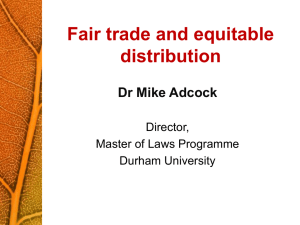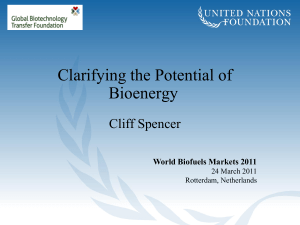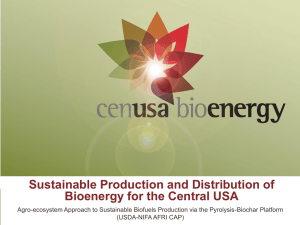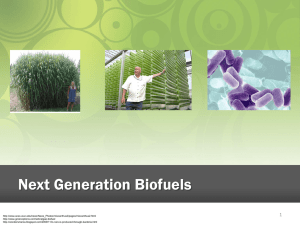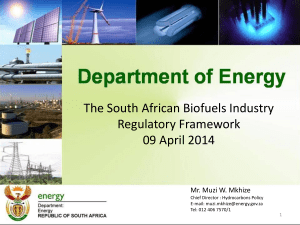Bioenergy, Ecosystems, and Livelihoods
advertisement
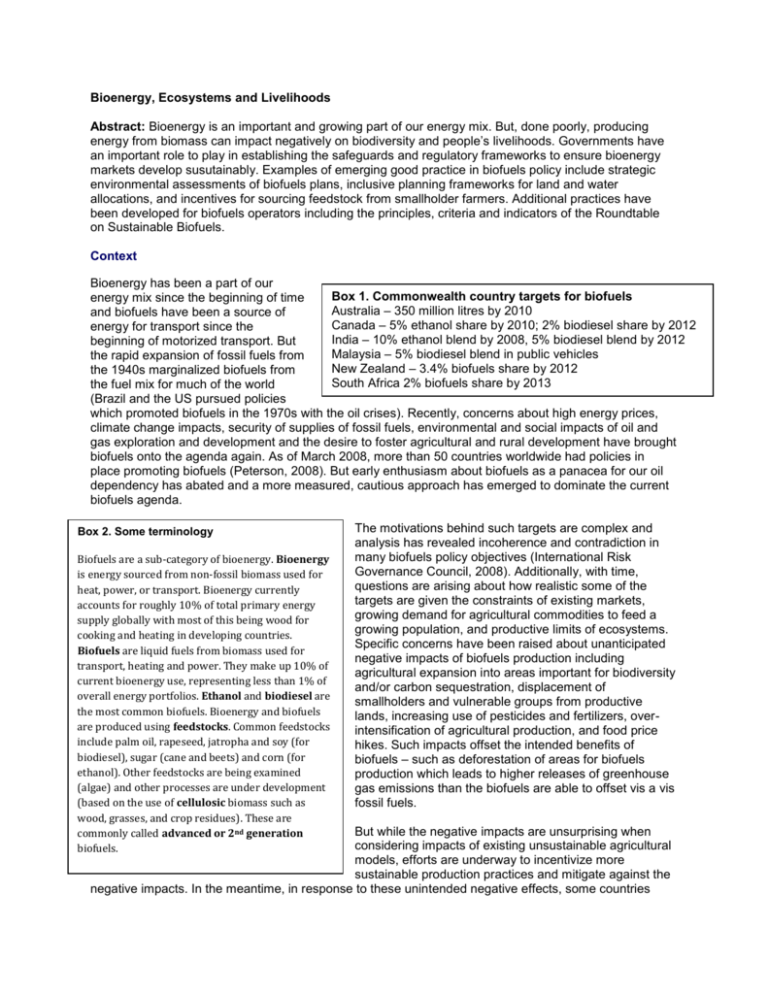
Bioenergy, Ecosystems and Livelihoods Abstract: Bioenergy is an important and growing part of our energy mix. But, done poorly, producing energy from biomass can impact negatively on biodiversity and people’s livelihoods. Governments have an important role to play in establishing the safeguards and regulatory frameworks to ensure bioenergy markets develop susutainably. Examples of emerging good practice in biofuels policy include strategic environmental assessments of biofuels plans, inclusive planning frameworks for land and water allocations, and incentives for sourcing feedstock from smallholder farmers. Additional practices have been developed for biofuels operators including the principles, criteria and indicators of the Roundtable on Sustainable Biofuels. Context Bioenergy has been a part of our Box 1. Commonwealth country targets for biofuels energy mix since the beginning of time Australia – 350 million litres by 2010 and biofuels have been a source of Canada – 5% ethanol share by 2010; 2% biodiesel share by 2012 energy for transport since the India – 10% ethanol blend by 2008, 5% biodiesel blend by 2012 beginning of motorized transport. But Malaysia – 5% biodiesel blend in public vehicles the rapid expansion of fossil fuels from New Zealand – 3.4% biofuels share by 2012 the 1940s marginalized biofuels from South Africa 2% biofuels share by 2013 the fuel mix for much of the world (Brazil and the US pursued policies which promoted biofuels in the 1970s with the oil crises). Recently, concerns about high energy prices, climate change impacts, security of supplies of fossil fuels, environmental and social impacts of oil and gas exploration and development and the desire to foster agricultural and rural development have brought biofuels onto the agenda again. As of March 2008, more than 50 countries worldwide had policies in place promoting biofuels (Peterson, 2008). But early enthusiasm about biofuels as a panacea for our oil dependency has abated and a more measured, cautious approach has emerged to dominate the current biofuels agenda. Box 2. Some terminology Biofuels are a sub-category of bioenergy. Bioenergy is energy sourced from non-fossil biomass used for heat, power, or transport. Bioenergy currently accounts for roughly 10% of total primary energy supply globally with most of this being wood for cooking and heating in developing countries. Biofuels are liquid fuels from biomass used for transport, heating and power. They make up 10% of current bioenergy use, representing less than 1% of overall energy portfolios. Ethanol and biodiesel are the most common biofuels. Bioenergy and biofuels are produced using feedstocks. Common feedstocks include palm oil, rapeseed, jatropha and soy (for biodiesel), sugar (cane and beets) and corn (for ethanol). Other feedstocks are being examined (algae) and other processes are under development (based on the use of cellulosic biomass such as wood, grasses, and crop residues). These are commonly called advanced or 2nd generation biofuels. The motivations behind such targets are complex and analysis has revealed incoherence and contradiction in many biofuels policy objectives (International Risk Governance Council, 2008). Additionally, with time, questions are arising about how realistic some of the targets are given the constraints of existing markets, growing demand for agricultural commodities to feed a growing population, and productive limits of ecosystems. Specific concerns have been raised about unanticipated negative impacts of biofuels production including agricultural expansion into areas important for biodiversity and/or carbon sequestration, displacement of smallholders and vulnerable groups from productive lands, increasing use of pesticides and fertilizers, overintensification of agricultural production, and food price hikes. Such impacts offset the intended benefits of biofuels – such as deforestation of areas for biofuels production which leads to higher releases of greenhouse gas emissions than the biofuels are able to offset vis a vis fossil fuels. But while the negative impacts are unsurprising when considering impacts of existing unsustainable agricultural models, efforts are underway to incentivize more sustainable production practices and mitigate against the negative impacts. In the meantime, in response to these unintended negative effects, some countries such as Germany, New Zealand and Thailand have reduced policy targets or support for biofuels, and others including Tanzania have put a temporary moratorium in place. Recommendations (IRGC, 2008; Ecofys, 2010; Global Bioenergy Partnership, 2010) for strong biofuels policy frameworks include: Developing regulatory structures which safeguard ecosystems and livelihoods Require operators to avoid and minimise negative impacts of bioenergy production on biodiversity and ecosystems including, in particular, water resources; Identify and implement measures to ensure that biofuels do not adversely affect food security. Develop and apply risk assessment methodologies such as full “cradle to cradle” lifecycle assessments and Environmental Impact Assessments (EIAs). Adopt internationally agreed definitions, sustainability standards and criteria for certification (such as the Roundtable on Sustainable Biofuels) and promote these to be recognised under international trade rules. Identify ways of ensuring biofuels provide benefits to feedstock producers, particularly vulnerable groups such as the rural poor, women and indigenous peoples. Incentivize production methods that use water efficiently and sustainably, favour the planting of native species, and avoid the planting of potentially invasive species. Ensure vulnerable and affected groups are able to participate meaningfully in decision making processes which are likely to affect the access to land and resources. Undertake landuse planning exercises which bring biodiversity (and other) information into inclusive multi-stakeholder, multi-sectoral processes of negotiating the trade-offs between land and resource use alternatives. The Importance of Landuse Planning Land use planning and governance is central to the implementation of sustainable biofuels. Because biofuels and bioenergy is derived from biomass produced in agricultural and forest systems (and potentially marine and freshwater systems as well) bioenergy policies should be developed with input from ministries dealing with energy, environment, agriculture, forestry, climate change, economic development, and trade. The IRGC noted that the food-fuel conflict is being exacerbated by policies that favour the diversion of food crops into biofuels production (in order to compensate for oil price increases and their impact on food prices), at a time when other demands on finite land resources – for food production, housing, recreation, nature conservation, and so forth – are also increasing. Likewise, evidence from Eastern and Southern Africa has indicated that vulnerable groups are more likely to be displaced by biofuels production where land tenure and access regimes are weak. Implementation of robust land-use policies which will reduce the risk of land with recognised high biodiversity value or high carbon stocks being converted to grow biomass feedstock, and encourage the use of abandoned land, but only when environmentally, economically and socially appropriate. Experiences from IUCN’s networks working on landscape planning provide insights to how to work with local stakeholders to learn about and influence landscape change. These principles (Box 3) provide a useful guide for biofuels developers and policy makers. Box 3. The “Lally Principles” Principles to negotiate and measure outcomes with stakeholders (Jeff Sayer, Louise Buck, and Sara Scherr) www.landscapemeasures.org 1. Use caution on entry. 2. Invest in skilled facilitation 3. Share ownership of the process 4. Understand institutional context 5. Focus on landscape functions 6. Search for synergies 7. Recognize different scales 8. Begin small and expand 9. Understand landscape dynamics 10. Explore scenarios fully 11. Select aims and indicators carefully 12. Choose comprehensive indicators sets 13. Make trade-offs explicit 14. Embed tracking measures in long-term management arrangements 15. Prevent high-tech tools from driving the process 16. Learn from failrures 17. Embrace change 18. Identify stakeholders 19. Be transparent about the opportunities Promote realistic targets While biofuels and bioenergy policies project into future, they need to be for effective in taking into account limiting factors including uncertainty around land, water, labour and how climate change will affect these. Biofuel targets most often cannot be met nationally, which implies trade. For example, currently the UK only provides 10% of its biofuel target locally, 90% is imported from a range of countries, including some in Africa that are facing food security problems. Trade is not just related to feedstock, but also so-called “land grabs” and disputes over their associated resources, including labour and water. Policy makers should assess realistic capacities to produce domestic feedstock for bioenergy, avoiding over-optimistic projections about the potential production. The IRGC also recommended that biofuel policy makers develop adaptive regulatory frameworks that set the conditions for transparent and balanced markets for producing and exporting countries to meet, first, their domestic needs, and, second, the needs of international trade. At the same time, governments should foster research and development to promote more advanced forms of bioenergy which may require less land and may enable the more efficient use of wastes and non-food feedstock. Conclusions Nobody should expect bioenergy alone to achieve the objectives of energy security, GHG emission reductions and sustainable development. Bioenergy is a relatively modest part of a comprehensive, sustainable energy policy in which all the various options are employed optimally, including energy efficiency, conservation, and appropriate technologies. Biofuels have a small but significant role in meeting future energy demand and accordingly, the targets and mandates that are in place worldwide are likely to remain in place. Moreover, the demand for biomass will increase with additional targets around biomass for heat and power as well as an alternative to fossil fuel as a source for biochemicals. Thus it is imperative that policies and practices are established to manage associated risks and that ensure that future biomass production give full account of the associated risks not exacerbate existing biodiversity degradation and social tensions. Importantly these include landuse planning and policy frameworks that leverage global knowledge about sensitive areas and species, and that enable local stakeholders to engage in meaningfully in decisions affecting them. Author biography: Andrea Athanas is Senior Programme Officer with IUCN’s Business and Biodiversity Programme. She is responsible for IUCN's work on energy, ecosystems and livelihoods. Organisation information: IUCN, the International Union for Conservation of Nature, helps the world find pragmatic solutions to our most pressing environment and development challenges. IUCN promotes a rapid transition to sustainable energy sources by developing practical tools for managing biodiversity impacts of all kinds of energy options and by advising governments, communities and companies on energy strategies that support livelihoods and have minimal impacts on ecosystems. Contact details Andrea Athanas Senior Programme Officer Energy, Ecosystems and Livelihoods Business and Biodiversity IUCN (International Union for the Conservation of Nature) 28 rue Mauverney, Gland 1196, Switzerland tel. +41 22 999 0213 Fax: +41229990020
